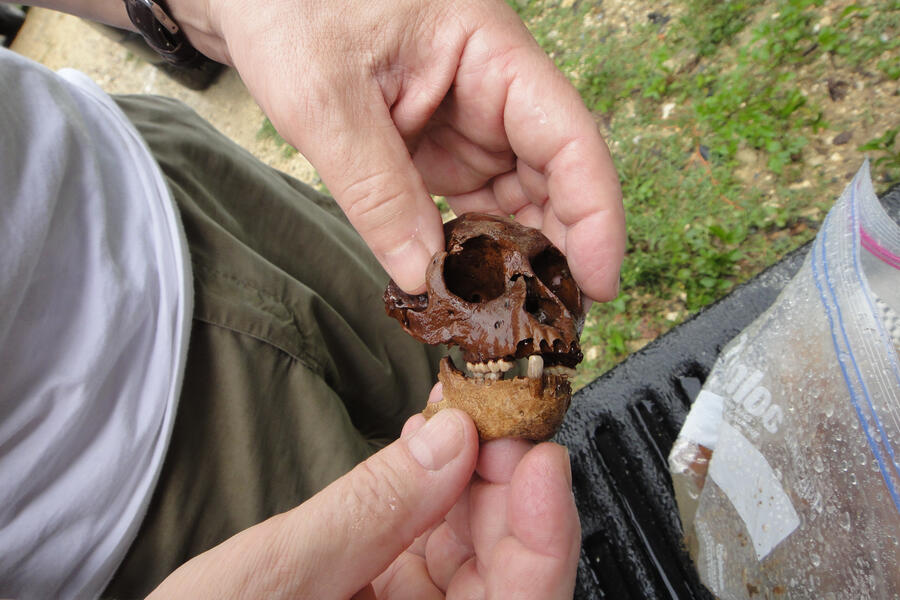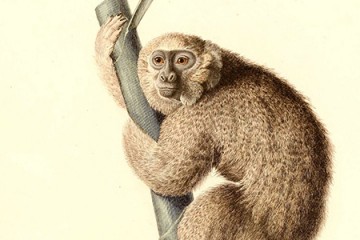In her travels to far-flung corners of the globe, Siobhán Cooke is always on the hunt for teeth.

Image caption: Siobhán Cooke
Creepy collector she is not; Cooke's quest for canines, incisors, and molars is driven by a desire to better understand Earth's past. Give this intrepid paleontologist a fossilized tooth, and there's a good chance she can tell you what type of animal it came from, what that animal was eating, when it died, and so much more.
"Teeth are little tools, and looking at the tool can tell you something about what it's used for," Cooke says.
An associate professor of functional anatomy and evolution at Johns Hopkins, Cooke has spent more than a decade showing her fellow scientists what can be gleaned from studying ancient teeth. Although she studies all kinds of mammalian fossils, her study of fossilized teeth in particular has offered a unique glimpse into the history of life on our planet. She's discovered new species and gained new insights into the ecology, evolution, and demise of many long-extinct species. Much of her research focuses on mammalian extinction in the Caribbean, which has lost 90% of its non-flying mammals since the Late Pleistocene.
When an ancient tooth comes into Cooke's lab, be it from a cave or a museum's collection, the first thing she does is pop it into her 3D scanner. Creating 3D models of teeth allows her to glean bits of information from every crack, dip, and crevice. It's also a critical step, given that other methods of study, such as isotope analysis and DNA sampling, often require procedures that damage the tooth.
There is much that can be learned, Cooke says, by studying the shape of and wear and tear on a tooth. "Different parts of the dentition can really help us get a full picture of that animal's behavior in terms of ingesting food, processing food, and what that food is," Cooke says. For example, primates that evolved to eat leaves tend to have sharper, wear-resistant molars, while those that evolved to eat fruit have flatter, less durable molars.
Knowing what an animal evolved to eat is important, Cooke says. "What an organism eats is closely aligned with its ecological niche and its evolutionary history." She can also determine an animal's body size and, in some cases, its mating strategy from its teeth. "Among primates in species where there is a lot of male competition for mating opportunities, males have selective pressure to maintain large canines, both for aggressive interactions with other males and for purposes of display," Cooke says.
While all types of ancient remains are valuable to science, teeth— protected by enamel, the hardest substance in the body—are more likely to survive the ravages of time, pressure, and erosion. In fact, the oldest DNA ever extracted came from the tooth of a woolly mammoth that lived 1.2 million years ago.
"Teeth are often the only evidence of a mammalian species recovered in the field, and these fossils can provide a valuable window into the paleobiology and phylogenetic relationships of the extinct animal," Cooke says.
Cooke first started seeing teeth as time capsules in 2006 while working on her PhD dissertation. She was trying to determine what caused a group of primates to go extinct in the Caribbean some 5,000 years ago, but the only clues she had were the scores of teeth left behind.
One of the most important teeth at her disposal came from the skull of a long-extinct monkey, Antillothrix bernensis, found in a flooded cave in the Dominican Republic. This and other specimens provided her with valuable information about the ecology of the Caribbean's long-lost mammals, which allowed her and her colleagues to examine patterns of extinction. Unsurprisingly, her research suggests that most of the mammals in the Caribbean went extinct shortly after the arrival of humans, owing to a combination of habitat change, hunting, and the introduction of invasive species.
Cooke has since studied everything from extinct giant terror birds to modern-day chimpanzees, but her curiosity about the flooded cave that helped spark her love of teeth never faded. She recently got her hands on a set of fossils from that same cave, including types of teeth from Antillothrix bernensis, that had never been studied.
Cooke's study of these fossils suggests that the extinct monkeys' diet consisted mainly of fruit and that males and females of the species were similarly sized, weighing up to five pounds.
These discoveries, Cooke says, serve as a reminder of the importance of preserving paleontological sites. "In the Dominican Republic, the government is sponsoring a lot of touristic development, and that is resulting in many of these paleontological sites being destroyed for the building of new airports and hotels," she says. Her collaborators in the Dominican Republic are working hard to excavate sites as quickly as possible before they're destroyed.
"We're in the midst of a sixth extinction right now as a result of anthropogenic changes to the environment," she says. "Protecting and studying sites where we have a good historical and archaeological record of the human impact on the environment can help us better understand where we are today."
Posted in Science+Technology
Tagged anatomy, fossils, evolution, evolutionary biology










